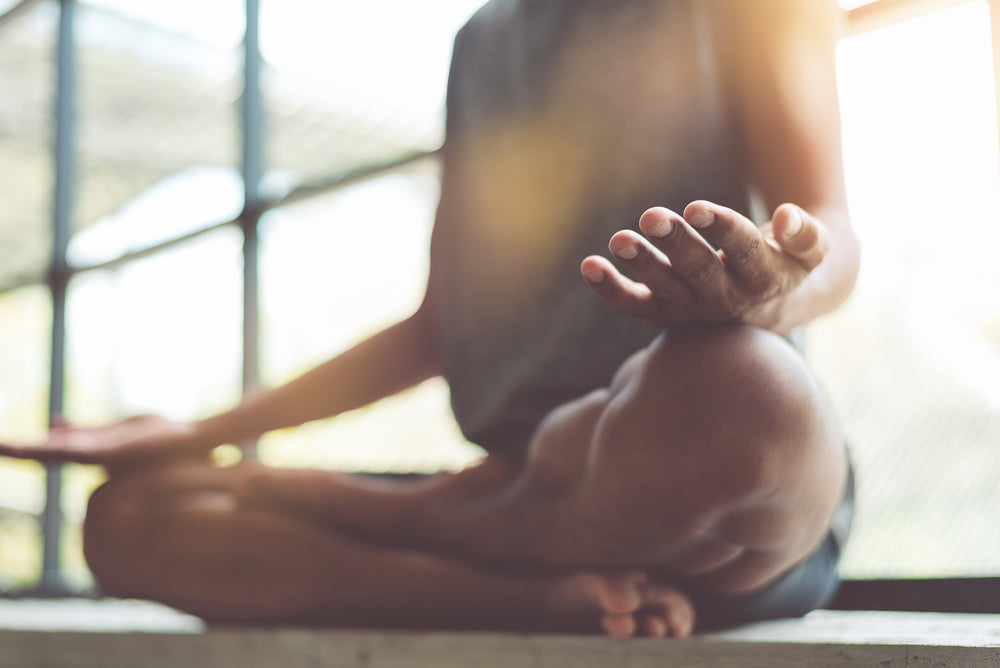Meditation is a great way to heal by clearing your mind and focusing on the present. However, it can be very hard to clear your mind for meditation when you have a constant pain in your back. Back pain during long periods of meditation is aggravated because bodies are not meant to stay in one position for so long, especially if you have experienced back pain in the past. Whether your back pain during meditation comes from your practice or from a preexisting back condition, there are a few things you can do to avoid pain during meditation. Maintaining correct posture and strengthening your core may be the most important and effective ways to meditate without back pain.
Basic meditation posture
Most meditation practices have you sit cross-legged on the ground, with a pillow for support. This position is called Sukhasana. We will discuss this basic meditation posture and how to best utilize it, and later we will discuss other options for back-pain-free mediation positions.
5 reasons you experience back pain during meditation
Focusing on five common alignment mistakes that yogi trainer Amy Ippoliti suggests you avoid will help you stay away from not only back pain but also hip pain, knee pain, and shoulder pain.
You have a bad cushion. The key to good cushioning is to make sure your knees are at or below your hips. You’ll know you’re sitting too high if your pelvis tilts too far forward as if your hips are on top of your femurs, which causes your legs to fall asleep. The best kind of cushion is a hard cushion so that it tips your tailbone into the body.
You sit with an uneven pelvic tilt. You don’t want to tilt your pelvis too far back or too far forward. If your pelvis is tipped too far back, you will likely experience excess lower back pain. If you’re tipped too far forward, you will likely experience hip pain. Keep your pelvis vertical while maintaining the natural curvature of your spine during your meditation.
You sit up too straight. What I mean by this is that you over correct your posture by bringing your mid-back too far forward. Strengthening your core will help you maintain the correct position. Keep your shoulders back, but bring your center so it stays under your head in the middle of your body, not out in front of you.
You slouch your shoulders. One of the easiest ways to keep your shoulders back is to place your hands closer to your hips. With the shoulders, you want to keep them close to the middle of your body as well. Don’t push your shoulder blades together, and don’t let your shoulders fall forward. Maintaining balance in the middle of your body will help you avoid back pain.
You misplace your head. You are trying to escape your thoughts during meditation, but you don’t want to lose your head. When you bring your shoulders back, make sure you don’t overcorrect and tuck your chin in by looking down. Keep your head lifted up like someone is pulling up on a string connected to the top of your head. Make sure you don’t poke your head out forward as well.
Other back-pain-free mediation positions
There are other options for back pain relief during meditation if you can’t seem to get comfortable in Sukhasana, the basic meditation position.
Siddhasana: Siddhasana is very similar to Sukhasana. Bring the right heel into your body so that it rests against your pubic bone. Tuck your left foot in the crease between your thigh and calf. This pose requires a lot of flexibility, but if you can work up to it, it can also help with your back pain.
Vajrasana: Kneel on the ground. Rest your butt back onto your heels, bringing your heels out slightly like a bowl so that your butt can rest comfortably there. You can also put a cushion between your feet and your butt for extra comfort. This pose is worse for your knees, but it relieves your lower back of pressure.
Virasana: This is the same as Vajrasana, but instead of sitting on your feet, you sit in between your feet.
Sit in a chair: Simply sitting in a chair is a great way to meditate. The key to meditation is focusing on the present and clearing your mind. It doesn’t necessarily matter how you sit.
Lean back against the Chirp Wheel: Sit in the basic meditation pose and lean back against the Gentle Chirp Wheel+ for extra support on your lower back. Do this until you feel strong enough to meditate without using the wheel.
How to cope with persisting pain
Check out more blog posts like these exercises to do before your meditation session or these core strengthening exercises. If you have chronic or unmanageable back pain, go see a doctor for help. However, even maintaining the correct posture for a long time will cause aches. Sarah Beach suggests, “when you experience itching, pain, or discomfort during meditation, bring your awareness to the sensation. What does it feel like? Where exactly do you feel it? I find that doing this immediately lessens the sensation of pain or irritation.” Once you've mastered meditation without pain, the next step is to master meditation without falling asleep.
References
Beach, S. R. (2017, December 7). 6 Meditation Problems That Aren't Really Problems: But Here's How to Fix Them, Anyway! Retrieved from https://www.huffpost.com/entry/meditation-practice_b_5519349
Ippoliti, A. (2011, June 1). The 5 Most Common Alignment Mistakes in Mediation. Retrieved from https://www.youtube.com/watch?v=qil5mmjuaIs
Lasater, J. (2007, August 28). Adjust Your Meditation Seat to Prevent Back Pain and Meditate Fully. Retrieved from https://www.yogajournal.com/meditation/sit-up-and-take-note
Lavendaire. (2016, September 21). How to Meditate. Retrieved from https://www.youtube.com/watch?v=oq6j9uWrcfg&vl=en
Rodriguez, H. (2019, December 29). Reduce Back Pain From Long Sitting During Meditation. Retrieved from https://www.threejewels.org/blog/reduce-back-pain-during-meditation








